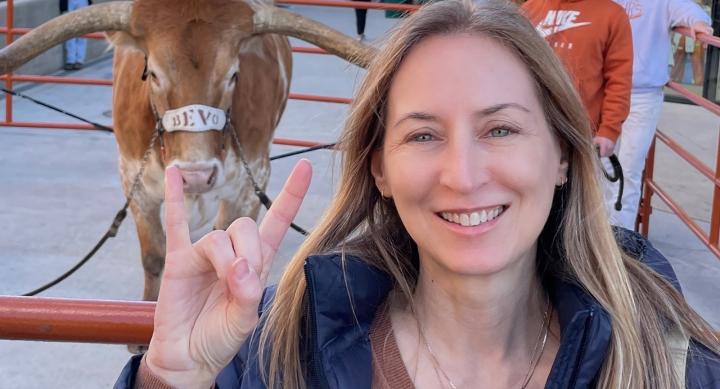
Carin Peterson is no stranger to working with animals. A UT graduate, she has a background in zoology and wildlife biology that prepared her to work with bats, reptiles, and endangered birds as a field biologist and researcher. She also worked as a zookeeper, veterinary technician, technician with the U.S. Department of Agriculture, and ranch hand before joining UT to develop Animal Make Safe, a program in the Environmental Health & Safety (EHS) department that works to minimize negative interactions between the campus population and wildlife by safely and humanely responding to live animal incidents. Today, Peterson, who has been with UT for 25 years, leads that program and contributes to the mission of the University by providing outreach and training on the services in EHS, which ensures that UT’s world-class campus experience is also safe for students, faculty, staff, and visitors.
1. What does your job entail, and what should more people know?
Part of my job entails working with Animal Make Safe. We use a number of techniques including capture and removal, live trapping, and exclusion to keep campus safe from wildlife. The animals we see the most getting into spaces where they shouldn’t be are bats, raccoons, opossums, snakes, and birds. Animal Make Safe also reviews and approves requests from colleges and schools that want to include animals as part of special events. They work with outside public health agencies to investigate potential health risks concerning wildlife, and they consult with student groups that may work with wildlife.
Something people may not know is that through Animal Make Safe, we respond to over 150 wildlife incidents (on average) and facilitate about 50 events involving live animals every year. In addition, we are constantly monitoring the wildlife population on campus. We collect data on what species are here, where they are, and what they are doing. I’d like to think that at most times we have a pretty good picture of what’s up with our wildlife.
The outreach side of my job involves working with EHS subject matter experts to create safety training, managing our website, and in general promoting safe practices and our services to the campus community through various outlets such as informational posters, signs, and by participating in campus events to raise awareness about our department.
2. What's the most intriguing thing you've encountered in your work?
A porcupine! We received a call for a porcupine in the UTA parking garage. This is very unusual, as they are not urban animals and have only recently expanded their range into Central Texas. My guess is it must have hitched a ride in a vehicle coming from a more rural location and wandered into the garage.
3. What do you like most about your job?
My job investigating animal incidents has taken me from the tunnels underground to the top of the Tower and everywhere in between and to almost every building to see where an animal may be entering a space. I’ve gotten to experience a side of campus that not everyone sees. I enjoy working with the wildlife, but my current role also allows me to step away from that and delve more into my creative side by using design software to develop promotional and collateral materials. It’s a great combination of science and art.
4. What's the best piece of professional advice you've received?
Eat the frog. This comes from a quote by Mark Twain. “If it’s your job to eat a frog, it’s best to do it first thing in the morning. And if it’s your job to eat two frogs, it’s best to eat the biggest one first.” In other words, tackle your hardest task first. It builds momentum for the rest of the day, week or even the year, as the case may be.
5. What is one of your favorite places on campus, and why?
I’ve spent so much time on this campus I feel it’s a part of who I am. There are many places and architectural features that resonate with or hold particular significance to me. The turtle pond and the Texas Science & Natural History Museum are two of my favorites. It’s been a journey to experience both places as a student, a staff member, and again as a parent, and I love being able to share them with my family. In addition, I’m a huge fan of the pterosaur (Quetzalcoatlus northropi) that hangs in the museum’s Great Hall!

